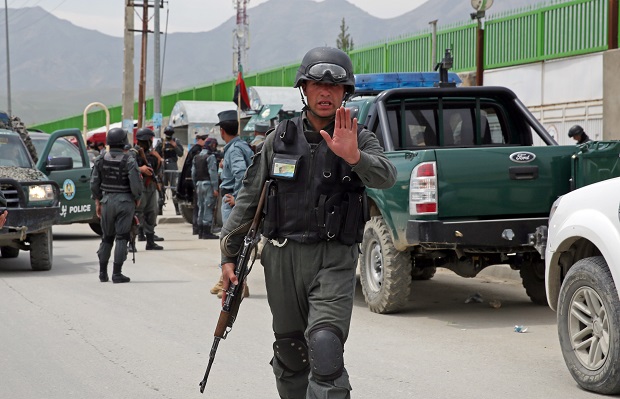
An Afghan policeman prevents journalists from approaching Cure International Hospital in Kabul, Afghanistan, Thursday, April 24, 2014. The U.S. embassy in Afghanistan says three American doctors have been killed at by an Afghan security guard who opened fire at a hospital in Kabul. The shooting at Cure International Hospital in western Kabul was the latest attack on foreign civilians in the Afghan capital this year. AP/Massoud Hossaini
KABUL, Afghanistan — It was midmorning at Cure International Hospital in Kabul when Dr. Jerry Umanos took a phone call. He told co-workers he had to meet some guests at the front gate and would be right back.
Minutes later, Umanos and two of his American guests were dead, gunned down by an Afghan police security guard. Another American was wounded.
A day after Thursday’s attack at the hospital run by a U.S.-based Christian charity, those colleagues were mourning the pediatrician known as “Dr. Jerry” who treated children and helped train Afghan medical workers.
The identities of the Americans gunned down beside Umanos have not been released, and other details of the latest attack on foreigners in Kabul, such as the motive of the gunman, remain unclear. Two of the dead visitors were described only as a father and son.
Thursday began at the hospital like most other days, with the 57-year-old Chicago pediatrician talking with Afghan doctors and checking on the progress of the 30-40 children who are patients, according to Dr. Noor Ahmad, a physician at Cure. Umanos had been working in Kabul for at least seven years.
No one thought much about it when he received a call to come to the hospital’s front gate to escort some visitors inside, Ahmad said.
“Then, inside the hospital, a terrible sound of guns was heard,” he said.
By the time terrified staff reached the scene, Umanos and two other men were dead, and an American woman was wounded in the left hand and chest, Ahmad said. He said he never learned who the visitors were but assumed they were trainers for a disaster preparedness course the hospital was planning for Sunday.
“It’s very terrible. I didn’t sleep last night,” Ahmad said.
Cure International Hospital has about 100 beds and a staff of 26 doctors and 64 nurses. It is located on the western outskirts of Kabul, near the hollowed-out ruins of Darulaman Palace that was destroyed by the civil war in the 1990s.
The hospital compound has a front gate and a security post set about 50 meters (yards) back, with the main building set farther back in a courtyard.
Umanos went to the gate at about 9:50 a.m. to greet and sign in his visitors, said Hafiz Khan, police chief of Kabul’s District 6.
As the party walked toward the hospital and approached the security post, the police guard raised his Kalashnikov rifle and opened fire, Khan said.
“After that, he put the barrel of the Kalashnikov to his stomach and shot himself,” Khan said, confirming the account by Cure International. Earlier, an Afghan police spokesman had said the attacker was shot by other security forces.
Umanos’ colleagues saved his killer’s life by operating on his wounds. The shooter was recovering Friday in an Interior Ministry hospital, Khan said
Identified as a low-ranking policeman named Aynuddin, the attacker has been on the police protection force for about 18 months, Khan said.
It was still unclear what prompted Aynuddin, who like many Afghans uses only one name, to open fire.
Such “insider attacks” are sometimes claimed by the Taliban insurgency as proof of their infiltration. Others are attributed to personal disputes or resentment by Afghans who have soured on the continued international presence in their country more than a dozen years after the fall of the Taliban’s ultra-conservative Islamic regime.
Foreign aid workers, contractors and other civilians in Afghanistan are increasingly becoming targets of violence as the U.S.-led military coalition continues a withdrawal to be complete by the end of the year.
So far this year, at least 21 foreign civilians have been killed in attacks in Afghanistan, while 18 NATO troops have been killed, according to an Associated Press tally. Afghan civilians still suffer the most, with 2,959 killed in 2013, according to the U.N.
“Afghanistan is definitely in the top five of dangerous countries for aid workers,” said Larissa Fast, an academic at Notre Dame’s Kroc Institute for International Peace Studies who has written a book about risks for humanitarian workers.
The U.S. Embassy, which was not identifying the victims because of a request by relatives, said in a statement that those killed at Cure Hospital were “humanitarian workers dedicated to improving the lives of Afghans by providing a full range of medical services including reconstructive surgery to children with physical disabilities and pre- and postnatal care for mothers.”
Jan Schuitema, Umanos’ wife, said in Chicago that he always wanted to work with children and became fascinated with Afghanistan when visiting in 2006.
“What he would really want people who care about this to know is that he really did love Afghanistan and the Afghan people,” said Schuitema, a teacher who also spent time teaching in Afghanistan.
She added that while violence in the country was “a reality,” the couple did not live in fear.
Ahmad said the hospital has temporarily stopped taking in new patients, but continues to treat those — about 100 — who are still there. They include about 30 children, who Ahmad said were Umanos’ patients.
“We are just so, so sorry. I can’t get it out of my mind,” Ahmad said. “He trained more than 50 Afghan doctors. He was just like our brother.”
RELATED STORIES
Chicago mayor, Fil-Ams mourn doctor killed in Afghanistan
Afghan hospital guard kills 3 US doctors, including Fil-Am pediatrician